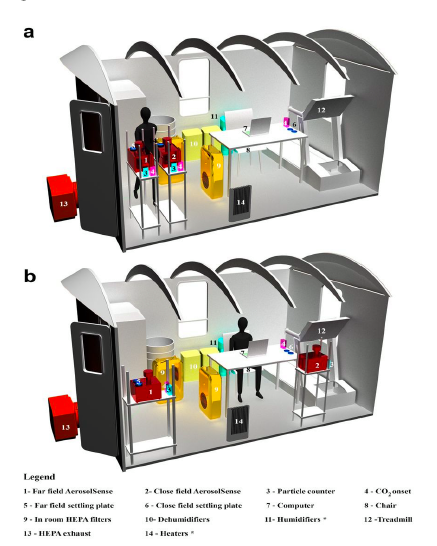They put COVID-19 infected people in a room and measured how much virus was in the air under different conditions.
❓What did they find?
TL;DR:
➡️ The more virus the person had in their nose, the more was in the room (shocker!)
➡️ HEPA FILTRATION reduced viral load in the air the most
➡️ Increased VENTILATION (air exchanges per hour) also reduced viral load
➡️ Higher relative HUMIDITY reduced the viral load in the air
The study recruited 11 participants that were diagnosed with COVID-19 and studied each for 3 days in a “controlled chamber.” They collected both biological and environmental samples to test for viral load.
Each participant conducted a cough test, speak test, and “speak loudly” test at the beginning of each day, followed by carrying out regular office activities under different combinations of filtration, outdoor air exchange and relative humidity levels.
💥 HEPA filtration had the biggest impact on reducing aerosol viral load. HEPA filters reduced the aerosol viral load *10-fold* compared to control conditions.
➡️ Look for a unit with a HEPA filter and a clean air delivery rate, or CADR, of 300 cubic feet per minute (not hour) or better, without extra bells and whistles.
You can also try a DIY Air purifier.
❓Why is humidity important? Aerosols evaporate more readily at lower humidity and can stay airborne longer longer.
💥 Humidifiers in the winter can help! Maintaining relative humidity in the 40%-60% range in indoor spaces is recommended. Higher than that can encourage mold growth.
They Nerdy Girls like this study as it’s one of the first we’ve seen testing viral output from people actually infected with SARS-CoV-2 rather than under simulated conditions. This means these results probably generalize well to conditions in the real world when an infected person is in an enclosed space.
❓What are we left wondering?
The study didn’t include direct measures of transmission to uninfected people (since it would be unethical to expose people to COVID-19 experimentally!). But it’s probably safe to assume that dramatically lowering the viral load in the air is important for transmission.
❓What about masks?
The study didn’t include masks as one of their experimental variables (🤷♀️), but another recent paper measured aerosols from COVID-19 infected people and found that masks (cloth and surgical) significantly reduced viral RNA shedding (link below).
➡️ BOTTOM LINE:
“Our findings indicate that building operation practices such as ventilation, filtration, and humidification substantially reduce the environmental aerosol viral load, and therefore inhalation dose, and should be prioritized to improve building health and safety.”

Links:
“What everyone should know about ventilation and preventing Covid-19”
“Indoor Air Changes and Potential Implications for SARS-CoV-2 Transmission”
“Infectious SARS-CoV-2 in Exhaled Aerosols and Efficacy of Masks During Early Mild Infection”


